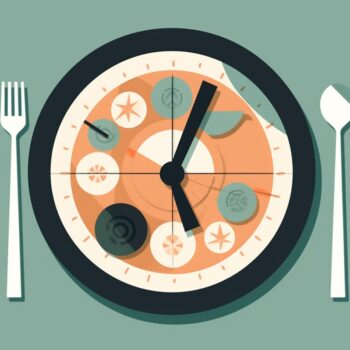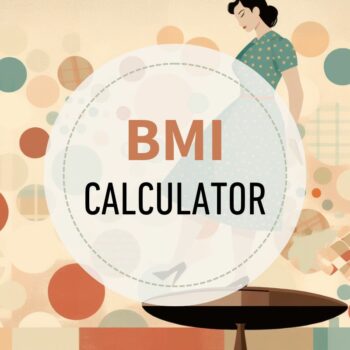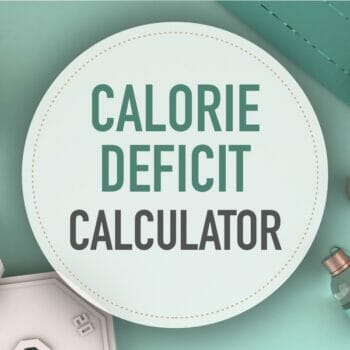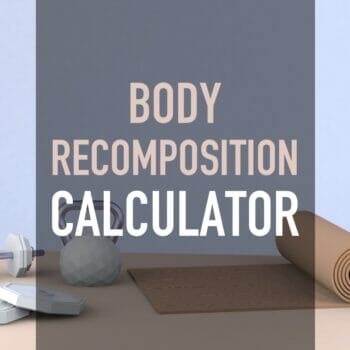Macro Calculator
This free, easy-to-use macro calculator gives you your optimal macronutrients and calories. It’s a weight loss or muscle gain calculator for both women and men.
Combine with macro counting or flexible dieting to reach your goals faster.
How to get leaner and stronger?
Our comprehensive macro-based fat loss program shows you how. Learn more
How do macros work?
The foods we eat are made up of three macros (macronutrients). These are carbohydrates (carbs), protein, and fat.
Chicken is high in protein but has no carbs; rice is high in carbs but has very little fat or protein. The three macronutrients provide the body with energy and raw materials for growth and repair.
By calculating the appropriate daily calorie amount for you, we can then break this down into the best macronutrient ratios to achieve weight loss.
Basic steps for macro counting
- Enter details into the calculator
Make sure to choose the correct goal. - Take note of your calories and macros
These will be the targets you are aiming for each day. - Track your macros
Use an app or pre-plan your meals. - Measure results
Don’t use basic weight scales.
Use proper body composition scales (we recommend Renpho) to measure fat and muscle mass changes.
What is a good macro ratio for fat loss or muscle gain?
Your macros should be based on your Total Daily Energy Expenditure (TDEE) and goals.
The calculator defaults to the best macro ratio proven to work for most people.
This ratio is:
- 30% fat
- Protein is 0.65 grams per pound of body weight,
- The remainder is carbs.
Depending on your goal, this will be either a calorie deficit or a surplus.
You can go further and make more adjustments: Perhaps you’re an extreme endomorph and do better with fewer carbs. Or perhaps you have one kidney and need to eat less protein.
You can fine-tune your results with a bit of math. See how to change your macros here.
What is a good protein ratio?
Rather than a percentage, proteins are based on your body weight. Our calculator has three settings:
- Moderate adjusts the ratio to 0.65 grams per pound of body weight.
This is appropriate for sedentary individuals or people with higher body fat percentages. - High is for active people with moderate strength training and an average body fat percentage.
- Maximum will set the ratio to 1 gram per pound.
This amount is good for bodybuilding and gaining muscle mass. You must be doing intense training.
Find out how to fine-tune your protein ratios when counting macros
Fat macro ratio
Set fat at 30% of daily energy expenditure.
Most people do very well with this amount of fat. See more about choosing the best macro fats. Because of high-fat diets like keto, many people are now eating more fat than they need to.
Carbohydrate macro ratio
Once you’ve calculated protein and fat, the remainder of your daily calories should be from carbohydrates.
Carbs fuel your body and workouts – and are the body’s preferred energy source.
If you are coming from a low-carb background, this may seem high. However, according to respected nutritional research, this is a moderate amount of carbs.
If you are eating according to your TDEE, the notion that carbs cause weight gain or stop fat loss is incorrect.
Using as a Calorie Deficit Calculator
As a weight loss calculator, this tool establishes a safe calorie deficit only.
The Lose option puts you in a 20% calorie deficit, promoting safe, steady weight loss.
The best macro ratio for body recomposition
If you want to recompose your body (lose fat and gain muscle simultaneously), then use the body recomposition calculator.
Macro ratio for maintenance
The Maintain button shows you the macro levels to maintain your current weight.
This is great if you have lost weight and don’t want to gain it back.
Macro ratio for muscle gain
The Gain button puts you in a 20% calorie surplus.
The macro breakdown is designed to build muscle fast in conjunction and must be combined with a comprehensive weight training program.
Underweight people can also use it.
TIP: Try starting with the maintenance goal and gradually increasing calories if you want lean muscle gains.
Calculating macros using your body fat percentage
The calculator uses your body weight to determine calories and macros.
However, you can obtain superior results by using your body fat percentage. The calculator allows you to choose which method: Normal for body weight, Lean Mass for fat percentage.
When to choose the Lean Mass Formula
If you are lean (have a low body fat percentage), choose the Lean Mass formula and enter your body fat %.
If you are classified as obese and have a lot of weight to lose, the lean mass formula is superior. You can read more about macro counting and obesity.
Help? Calculate your ideal body weight or get an assessment of your body fat percentage.
Why the difference? Muscle cells burn more calories than fat cells, so the more accurately we measure this, the better your results will be.
How to calculate macros per meal
You can break this down into meals once you’ve calculated your daily macros in the calculator.
Choose from 2 to 6 meals daily to see the macro ratio you can track for each meal. For some people, this is easier, but for others, this is too much detail.
Do what works for you.
Meal Plans
See a 5-day macro-based meal plan. It includes three meals and two snacks per day.
Macro calculator activity level settings
A higher activity level means a higher daily calorie goal.
For example – if you maintain your weight at 2,000 calories per day, adding vigorous daily exercise means you need more calories to maintain your weight.
If you are sedentary and trying to lose weight, adding exercise will increase your daily calorie goal.
The idea seems counter-intuitive, but more energy is required to fuel your workouts. More workouts lead to increasing metabolism; therefore, more fat is burned!
Undereating is one of the leading causes of the weight loss plateau.
So many of our clients previously “hit the wall” with dieting. They would continually reduce calories, stop losing fat, and gain weight when they eat a little more.
Macro counting defeats this by prescribing the right food and calorie levels.
Which activity level do I choose?
- Sedentary: Just regular everyday activity like a bit of walking, a couple of flights of stairs, eating, etc.
- Light: Any activity that burns 200-400 calories (females) or 250-500 calories (males) over your sedentary amount.
- Moderate: Any activity that burns 400-650 calories (females) or 500-800 calories (males) more than your sedentary amount.
- Extreme: Any activity that burns more than 650 calories (females) or more than 800 calories (males) in addition to your sedentary amount.
Other options for determining your calorie burn
- Use our calories burned calculator – it accurately assesses over 380 activities.
- Use a fitness tracker – like a Fitbit or Apple Watch (note that they can overestimate calorie burn).
- Use a suitable app – like MapMyFitness
Why should I eat more when I exercise more?
High physical activity not fueled with enough calories will lead to muscle catabolism (breakdown of muscle fiber).
This lack of nutrition could stall your weight loss, so eat up if you love to exercise!
I’ve got my macros – now what?
Once you’ve identified your target daily macros, you must determine the macros in all your foods.
By tracking them daily, you can reach your recommended macro targets that encourage fat loss, muscle gain, or whatever your goal may be.
You can learn more about the macro counting system and the flexible dieting philosophy. Many people use an app like Myfitnesspal to track macros.
For more specifics on what to eat – see a sample macro meal plan or a list of macros for familiar foods.
View article sourcesSources
- Mifflin, M. D., St Jeor, S. T., Hill, L. A., Scott, B. J., Daugherty, S. A., & Koh, Y. O. (1990). A new predictive equation for resting energy expenditure in healthy individuals. The American Journal of Clinical Nutrition, 51 (2), 241-247. Link
- McArdle, W. D., Katch, F. I., & Katch, V. L. (2010). Exercise physiology: nutrition, energy, and human performance. Lippincott Williams & Wilkins. Link
- Jequier, E. (1994). Carbohydrates as a source of energy. The American journal of clinical nutrition, 59(3), 682S-685S.
- Lemon, P. W., Tarnopolsky, M. A., MacDougall, J. D., & Atkinson, S. A. (1992). Protein requirements and muscle mass/strength changes during intensive training in novice bodybuilders. Journal of Applied Physiology, 73(2), 767-775. study abstract link
- Grundy, S. M. (1999). The optimal ratio of fat-to-carbohydrate in the diet. Annual review of nutrition, 19(1), 325-341. abstract
- Conlin, L.A., Aguilar, D.T., Rogers, G.E. et al. Flexible vs. rigid dieting in resistance-trained individuals seeking to optimize their physiques: A randomized controlled trial. J Int Soc Sports Nutr 18, 52 (2021). https://doi.org/10.1186/s12970-021-00452-2
2,104 Comments


 Menopause Macro Calculator
Menopause Macro Calculator Intermittent Fasting Calculator
Intermittent Fasting Calculator BMI Calculator
BMI Calculator Calorie Deficit Calculator
Calorie Deficit Calculator Body Recomposition Calculator
Body Recomposition Calculator
Hey Ted! I’ve been counting macros for about a year now. It’s been amazing. I’m looking to do a more extensive fat cut since summer is coming up. Some days, I cycle for 20 miles or so. Usually I burn somewhere between 800-1200… Would it be a bad idea to cycle my macros? For example, days that I cycle, I would eat the macros set at “very active”. Other days when I lift, I would eat the macros set at “moderately active”, since I am only burning between 400-700 calories in that workout. This idea makes sense in my head… I would eat two separate sets of macros depending on my workout for that specific day.. What are your thoughts?
Hi Kurtis, Great work on keeping at it for a year! Yes, this is totally acceptable. I actually track my exercise and eat my macros based on that. If I have a rest day, I cut back to my sedentary macros. I’m down to 9% body fat so far using this method. So, give it a try and keep us posted!
Hey Ted,
Any way to manually enter your own calorie amount and get macro amounts/percentages calculated? I’m breastfeeding so I used the calculator you linked to in another thread and so my calories are obviously higher than what this calculator gives me. It’s been working out pretty well–I’m losing weight but still eating stuff I enjoy and food that is actually good for me, but I’m having trouble getting all my carbs in so I’m wondering if I need to readjust. Thanks for your helpful articles!
Hi Sara, Great news and you’re welcome! No, there’s no way to manually enter calories on our calculator. However, you can do this on myfitnesspal if you use that tool. It will then show you your macros at the percentages you set.
I love how this calculator gives me totally different results with the same numbers entered whenever I refresh it.
That doesn’t sound so good. Would you be able to tell us exactly what you entered (and what browser you were using)?
We’ve tried to reproduce the problem but were unable to.
Hey Ted I am having some trouble with my food. I’ve been going to a nutritionist for a couple months and I haven’t seen any weight loss. We did a metabolic test (the thing you have to breathe into to determine your metabolism rate…I’m at 17.5 or something like that). I do 60-minute crossfit class on monday, wednesday, friday and saturdays each week (2-hr class on saturdays), 60 minute african dance class on thursdays and some running/strength training on tuesdays for 30-45 minutes. i’m 31, 157 lbs and would like to loose about 10-15 lbs, but haven’t seen any loss on the scale. according to the calculator i should be taking in 1750 calories (40%C, 35%P, 25%F), but my nutritionist has me at 1914 calories (50%C, 20%P, 30%F). Please help! What should I do if i want to lose weight?
Hi Alicia, which exercise level did you choose for our calculator?
moderate
Your exercise is pretty varied so perhaps you should use your sedentary weight loss TDEE / macros and then track your exercise each day, eating those calories burned back. You can use apps like mapmyfitness and myfitnesspal to help with this. I even have a guide that shows you how to set it all up. https://healthyeater.com/iifym-myfitnesspal-tutorial
Hey Ted,
Could you help me? I just started counting macros a week ago. I’m 23, 165cm, 201lbs, and I need to lose weight. I work a desk job and I’m always at work. I just started seriously working out a week ago too. Im going to try to do cardio for an hour 2x a week and lift weights for an hour 3x a week. I like the idea of setting it to sedentary and eating back the calories I burn is that bad to do or should I just set it to light activity and start from there? How often should I recalculate my macros? I feel like I have lost weight already even though I haven’t stepped on the scale yet. I love this site! Thank you for your help! -Danielle
Hi Danielle, Great! nice work so far. Either way works but I like tracking exercise as it accounts for varied levels better and for rest days. But, makes planning for meeting macros harder. Up to you really. I tell people to readjust after every 5 pounds lost or if they aren’t reaching their intended goals. Keep us posted on your progress and so glad you find our site helpful!
I’m 17 and I’m 5’7 currently weighing in at
168lbs which is the highest I’ve been. I dance for an hour and a half at my school and twice a week at a studio one day for 2 hours and 15 mins and a 45 mins class on another day. I also work out for about an hour mostly 4 times a week but occasionally 3 or 5 times. My first question is would my exercise be considered moderate? I’ve been searching for a successful way to lose fat and gain muscle. I’ve been watching how I eat and working but the number on the scale has only increased. Would counting macros work for me? When putting exercise as moderate It says 1961cal to lose with 229 carb, 139 protein and 54 fat..I know I shouldn’t obsess of the scale but the number still discourages me and I’m just ready to be happy and lean..no fat doesn’t hang over and I’m sure I have a lot of muscle from dancing and working out but I’m not sure why the number on the scale goes up and I don’t like feeling hungry or deprived all the time..any advice would be great!
Thanks
Hi Cassidy, Moderate seems correct based on what you described, but some days could even be very active. Days where you dance and workout. I would say give it a try as many have been successful with this method. Do you have any idea of how many calories you’re currently eating per day?
I like to stay around 1600
It seems like you weren’t eating enough before, especially on your heavy exercise days. this can slow the metabolism and be counterproductive, so using the flexible diet will be much better for you.
Hi Ana, I got a sedentary TDEE of 1466 for you by using our calculator. https://healthyeater.com/flexible-dieting-calculator. Since you are trying to maintain, I would recommend eating back any exercise calories on top of that by tracking your exercise since it varies so much.
Hey, Ted how’s it going? I am struggling here trying to get the correct and adjustments for my macros. I am currently 26 years old 5’6 196lbs. I workout 5-6 times a week from 45 min – 1.5 hrs a workout. I do weight training, body weight training, & HIIT. I have a desk job M-F as well. For the past couple weeks i been cycling my carbs, low for 3 days 1 day high, then repeat the cycle again. I feel like I am carb sensitive and I put on weight so easy. Should I go with the 40/40/20 split or higher protien and high fat route?
Hi Mike, It’s going well thanks! I’m not so sure about the carb sensitivity issue. If you eat more than your TDEE, yes you’ll gain weight and some do put on weight faster than others, but I don’t see much, if any research out there that confirms that carbs eaten at a level below the TDEE produces weight gain. There could be a few rare exceptions like people with thyroid disorders, but I think in general the carb sensitivity classification doesn’t hold much validity. For myself I’m getting much better results now that I track macros and eat all the carbs that fit opposed to eating a very low carb diet and not tracking macros. So my advice would be to eat at the percentages given by our calculator at lose, high protein, moderate exercise. during your exercise days. For any rest days you can cut back to your sedentary TDEE. I think you’ll find this is a lot less complicated and it will give you results. Just remember that for moderate exercise you need to have at least a 500 calorie burn at the gym, but this sounds right based on your description. Good luck!
Awesome, you really made it that much simpler. Thanks,
Okay, so I’m struggling a little with what to put in the calculator.
1. Activity Level: I usually workout 5-6 times a week anywhere between 30min and 1.5 hours. My workouts range from the elliptical, a p90x workout, an insanity workout, kickboxing (cardio & punching/kicking bags), hot yoga, and a trampoline based workout that also incorporates light weights/high repetition. I have a fitbit chargehr and it usually tells me I’m burning anywhere from 300-550 calories per workout. I am leaning towards selecting light activity. Do you suggest this from what you know?
2. Goal & Protein Adjustment: I’m 27, 5’8″ and about 145lbs so I’m not overweight, but with summer around the corner I would like to loose 5-10lbs and also tone-up. I know a month probably isn’t enough time to really do anything drastic with iifym, but I want to move in the right direction. So I was thinking of selecting Lose and then adjusting the protein to High. I came to this conclusion after reading a comment you posted elsewhere “I think it can be done as long as you are eating adequate protein, lifting heavier weight to keep muscle tissue stimulated, and are in a small calorie deficit. It will just take longer than a true cutting phase, which is designed to be quicker.” Do you think me selecting Lose/High protein would be a good approach?
3. How often are you supposed to re-calculate your calories/macros?
Thanks in advance. Appreciate your help 🙂
Hi Jamie, Your exercise seems varied so you may want to choose sedentary-lose-high-protein and then track your exercise and add those calories back in depending on how much you do that day. On rest days you would just be eating at your sedentary level. I use myfitnesspal to help with this and I have written a guide to set it all up here. https://healthyeater.com/flexible-dieting-calculator
If I plan to be doing p90 five-six days a week, should I be light or moderate activity? I am student and walk a lot on campus in addition, but soon I will be graduating and I will have a desk job. Can I leave my macros the same on rest days?
P90x is pretty intense so I would say go with moderate. Some leave macros the same during rest days while others cut back to sedentary levels. I usually advise people to start by not, but if they aren’t reaching their goals then cut back on rest days.
Its just the new “p90” instead of “p90x”. Still moderate? Thanks for the help! Excited to try this!
Oh ok, I just researched that a bit and see that it’s a less intense version so I would go with light. Good luck and keep us posted!
Hi!!!
Sure wish someone would make an app that addresses all the calculations we need.
MyFittnessPal is good but the protein doesn’t calculate as needed.
and
You say 1 gr = 4 calories but I have found many labels that are much less that this or much more.
Chicken = less Fatty Protein=more.
Not
complaining. Lost 7lbs my first week and just the fact that I am
keeping the food diary is a BIG helper makes me stay on track.
BUT some days I run out of carbs, or fat and have CALORIES left…so I just don’t eat.
Any advise???
Thanks!
Lynne
Hi Lynne, Congrats on your success so far!
I suggest read through a couple of our articles: 1st one is how to set up MFP to use your macros:
https://healthyeater.com/iifym-myfitnesspal-tutorial
2nd: I’m not sure you understand how to find macros in food as no chicken is gram/per gram protein regardless of how fatty it is. https://healthyeater.com/macro-amounts-foods .
Also, planning gets easier with practice so don’t stress too much about having leftover calories as long as it isn’t excessive.
I have done all that but am thinking I may need to “plan” my daily meals…lol
Yes, some planning ahead helps a lot until you get the hang of it. keep up the great work!
Hi isnt it true that losing weigh is just about calories in and out? So is it okay if i consume 40-40 on fat and carbs while only 20 on protein? Will that bring any different to my weight loss? Thx!
The macros are set depending on your goals, so they can be flexible. If you do any type of fitness or weight training I would say 20% protein isn’t enough.
I want to lose about 5 kgs.. And i dont do any exercise is it okay? So i will just consume 1200cals per day?
You should enter your stats above and select sedentary for exercise level, then select “lose”. This will give you the appropriate TDEE and macros for healthy weight loss.
Hi Ted,
So, it’s only been a week that I’ve been tracking my macros with MFP, before I saw this article. I’m 5’6″ 150… Which hasn’t changed in a week! Is tht normal? My macros have me eating 1230 cals approx…it seems strange that my weight hasn’t changed yet. I’m not sure what I’m doing wrong?
Hi Illinois, so what does our calculator tell you to do? Also what’s your fitness routine like and what was your diet like before flexible dieting?